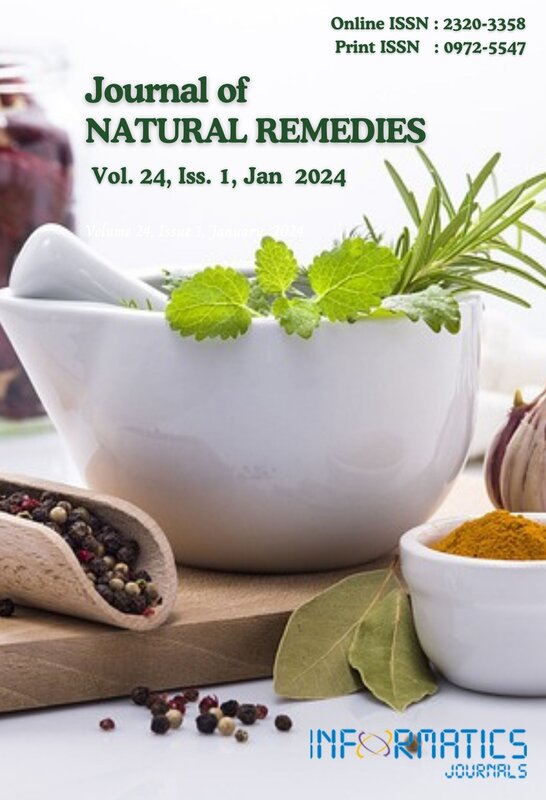Inhalation Therapy with Clerodendrum serratum Linn. Extract: An Experimental Study on Ovalbumin-induced Asthma in Rats
DOI:
https://doi.org/10.18311/jnr/2024/34453Keywords:
Selected:Asthma, Anti-inflammatory, Bharangi, Clerodendrum serratum, Herbal, Reduced Serum Leukocyte and Eosinophil Counts, Th2 CytokinesAbstract
Bronchial asthma is a chronic inflammatory condition marked by airway constriction, inflammation, and structural changes known as airway remodeling. Clerodendrum serratum Linn., a plant traditionally used in Ayurvedic medicine, has shown anti-inflammatory and bronchodilatory effects. This research work aims to study the potential anti-asthmatic properties of an inhalable formulation prepared from C. serratum extract in an ovalbumin-induced asthma rat model. The formulation was evaluated for its effects on serum leukocytes and eosinophils, mast cells, total tissue protein, airway inflammation, and histopathological changes in the lungs. The results showed that the inhalable formulation significantly reduced the symptoms of asthma in the rat model. The formulation led to a significant reduction in the levels of serum leukocytes and eosinophils, key indicators of asthma inflammation. It effectively stabilized mast cells, preventing their degranulation, and reducing airway reactivity. A decrease in total tissue protein levels was observed, suggesting reduced tissue damage associated with asthma. The formulation also demonstrated a substantial reduction in airway inflammation, as evidenced by histopathological changes in the lungs and reduced Th2 cytokines namely Tumour necrosis factor α and Interleukin 4, in bronchoalveolar lavage fluid. These effects may be attributed to the anti-inflammatory, mast cell stabilizing, and immunomodulatory properties of the formulation. The study provides scientific evidence supporting the traditional use of C. serratum in the treatment of asthma and demonstrates its potential as a therapeutic alternative for the treatment of respiratory diseases.
Downloads
Metrics
Downloads
Published
How to Cite
License
Copyright (c) 2023 Lima Patel, Dimal Shah, Hitesh Chandpa, Avani Khristi, Puja Bhavsar (Author)

This work is licensed under a Creative Commons Attribution 4.0 International License.
Accepted 2023-10-26
Published 2024-01-01
References
Xiufeng T, Honglei N, Xiaoxi L, Yan Y, Xiujuan W, Liping X, Haotian S, Xinwei Y, Renhui L. Effects of the combined extracts of Herbal Epimedii and Fructus Ligustrilucidi on airway remodeling in the asthmatic rats with the treatment of budesonide. BMC Complementary and Alternative Medicine. 2017; 17:380. https://doi.org/10.1186/s12906- 017-1891-0 DOI: https://doi.org/10.1186/s12906-017-1891-0
Centers for Disease Control and Prevention. Asthma; 2023. https://www.cdc.gov/asthma/default.htm
National Heart, Lung, and Blood Institute. Asthma; 2023. https://www.nhlbi.nih.gov/health-topics/asthma
Global initiative for asthma. Global strategy for asthma management and prevention, 2021; 2023. https://ginasthma. org/wp-content/uploads/2021/05/GINA-Main-Report- 2021-V2-WMS.pdf
Kumar PA, Nishteswar K. Phyto-chemical and pharmacological profiles of Clerodendrum serratum Linn. (Bharngi): a review. Int J Res Ayurveda Pharm. 2013; 4:2. https://doi.org/10.7897/2277-4343.04239 DOI: https://doi.org/10.7897/2277-4343.04239
Poornima BS, Prakash LH, Pradeep, Harini A. A Pharmacological review on Clerodendrum serratum Linn. Moon. Journal of Pharmacognosy and Phytochemistry. 2015; 5:126-30.
Tripathi I. Arka prakasa of lankapati ravana, krishnadas Academy, Varanasi. 1995; 43.
Arora P, Ansari SH, Nainwal LM. Clerodendrum serratum extract attenuates production of inflammatory mediators in ovalbumin-induced asthma in rats. Turkish Journal of Chemistry. 2022; 46:2. https://doi.org/10.55730/1300- 0527.3310 DOI: https://doi.org/10.55730/1300-0527.3310
Nageswari T, Ayesha K, Kumar B, Naresh BP. Evaluation of hydroalcoholic extract of Clerodendrum serratum Leaf for anti-asthmatic activity. International Journal of Pharmacometrics and Integrated Biosciences. 2017; 3:1:220-24.
Thakur VR. An experimental model of asthma in rats using ovalbumin and lipopolysaccharide allergens. Heliyon. 2019; e02864. https://doi.org/10.1016/j.heliyon.2019.e02864 DOI: https://doi.org/10.1016/j.heliyon.2019.e02864
Minqian W, Jenni F, Lin SL, Kit Y. A review on flavonoid apigenin: dietary intake, ADME, antimicrobial effects, and interactions with human gut microbiota. BioMed Research International. 2019; 7010467. https://doi. org/10.1155/2019/7010467 DOI: https://doi.org/10.1155/2019/7010467
Liu J. Pharmacology of oleanolic acid and ursolic acid. Journal of Ethnopharmacology. 1995; 49:57-68. https://doi. org/10.1016/0378-8741(95)90032-2 DOI: https://doi.org/10.1016/0378-8741(95)90032-2
Salvatore Ch. The role of quercetin, flavonols, and flavones in modulating inflammatory cell function. Inflammation and Allergy - Drug Targets. 2020; 9:263-85. https://doi. org/10.2174/187152810793358741 DOI: https://doi.org/10.2174/187152810793358741
Zhang L, Wang M, Kang X, Boontheung P, Li N, Nel AE, Loo JA. Oxidative stress and asthma: proteome analysis of chitinase-like proteins and FIZZ1 in lung tissue and bronchoalveolar lavage fluid. Journal of Proteome Research. 2009; 8:4:631. https://doi.org/10.1021/pr800685h DOI: https://doi.org/10.1021/pr800685h

 Lima Patel
Lima Patel









 0.35
0.35 24
24 0.161
0.161